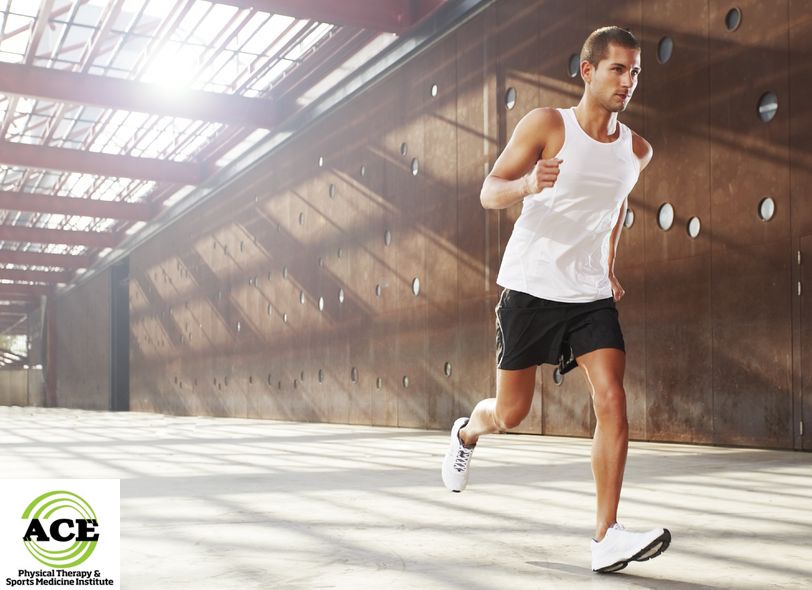3 COMMON RUNNING INJURIES
Avoiding Common Running Injuries
by ACE Physical Therapy and Sports Medicine Institute
Running Tid Bits.
- Estimates indicate that nearly 500,000 people are considered “runners” in the US.
- Elite runners have a step rate (cadence) of approximately 180 and the average runner is approximately 150 – 160.
- Mid and forefoot striking might decrease lower extremity injuries if the transition is performed correctly.
- Estimates of 35-50% of all runners suffer a yearly injury and 50-75% of those injuries are from over-use or repetition.
- Seek the treatment from a Physical Therapist if you get injured while running without seeing a doctor first.
Running is a whole body exercise. Proper training should involve the whole body. Three common running injuries can often be avoided if runners develop a cross training program that involves more than just running. Many, in fact most runners will not stop running and take time for a more comprehensive training regimen. The neglect of cross training and the constant repetitive pounding action of running can lead to injuries that inhibit running and interfere with daily activities.
Three common running injuries include low back pain, anterior knee pain and calf/Achilles pain. Physical therapists commonly help treat runner’s suffering from these conditions so they can recover and return to running. Physical therapists can also help a runner review both the training program and the runner’s form to develop a training regimen suited to the runner’s needs and helping the runner avoid common injuries.
Everyday, physical therapists treat patients suffering from low back pain. When an avid runner comes with the complaint of low back pain the evaluation can rule out any severe conditions that would require more testing and possibly follow up care with another healthcare professional.
If a soft tissue injury is suspected, the therapist can prescribe several exercise routines that will help to address core and hip weakness and decreased flexibility of the muscles and joints. The therapist may also recommend proper shoes. The exercise routine addresses a fundamental weakness that is present in nearly everyone: the need for core strengthening. The core is critical to all motions and movements, and it must be able to generate enough force during a contraction and have enough endurance to do it for a prolonged period of time, or it will be unable to control the different joints of the spine and pelvis. When this occurs in a runner, the lack of muscle strength and endurance can lead to an excessive amount of compressive and sheer force within the spine and cause an injury to happen. Additionally, many patients have very tight hamstrings and need to stretch them more frequently.
When a runner complains of anterior knee pain, the therapist may evaluate hip strength. While there are several factors that can cause anterior knee pain, a common cause is the lack of strength in several hip muscles. To evaluate, the therapist will have you stand on the step stool and then very slowly step down to the floor with each leg. As you move, the therapist assesses the movement and position of your knee when you are in mid-step down position. If your knee moves excessively towards the mid-line or into a valgus position, it can be assumed that the hip muscles of abduction, extension and external rotation are weak. Physical therapists can teach patients strengthening exercises as well as proper alignment during activities that require the knee to flex and weight bear at the same time. These will begin to eliminate one major cause of “anterior knee pain.”
Calf and Achilles tendon pain can limit someone’s ability to run very quickly. The calf muscles are connected to the heal bone via the Achilles tendon. If these muscles are over-used or too weak to handle the load that is applied, they may suffer injury when someone runs up to 7x the body weight. These muscles are responsible for the “heel off” phase of gait.
After the mid stance and the foot has pronated to absorb shock, the foot must be returned to a supinated position to create a rigid lever that is capable of propelling the body weight forward. The calf muscles via the Achilles tendon are responsible for this action. If there is hip weakness and an increased valgus moment at the knee during mid stance, this will have a detrimental effect on the muscles and tendon. If the foot anatomy allows too much pronation during mid stance, the muscles and tendon are subjected to abnormal amounts of force. Your physical therapist can help you with either condition.
There are specific exercises that should be performed to strengthen the hip and possibly a need for a custom or over–the-counter orthotic to help reduce the excess amount of pronation.
Running is a full body sport. It is a sport or activity that many people participate in every day. Unfortunately many of them get hurt and have to limit or stop doing it. The proper training techniques and routine can help someone avoid these common injuries and the most qualified person to help with the work out strategy is a physical therapist. injuries are from over-use or repetition.
Read more articles on our main website blog at: ACE-pt.org/blog
Vist our main website at www.ACE-pt.org


